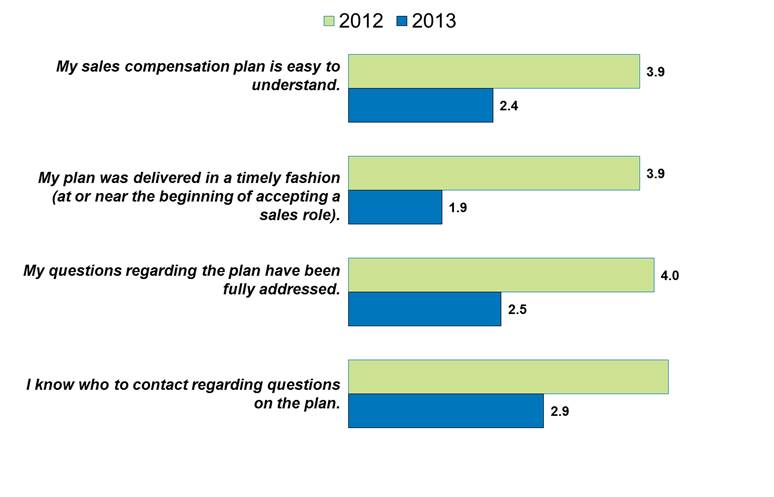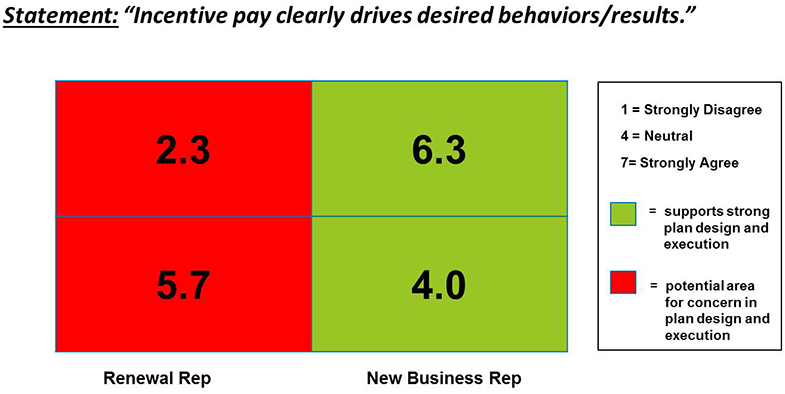Does the Perception of Your Sales Reps Matter?
When you stop and think about it, it’s a silly question. Of course the perception of your sales reps matters. As the saying goes, perception is reality. Yet how come so many sales leaders, let alone CEOs, don’t seem to bother to find out what their sales reps think? As some of you are reading this you might be justifying your actions by thinking, “Well we talk to our top performers on a regular basis, so we know how they think, and that’s all that really matters.” At the risk of sounding a bit harsh, “Really?” I’d like to suggest that the perception of your entire sales force matters. And as a sales leader you should keep a good “pulse” on what your sales force perceives about a variety of topics on a periodic basis. Here are five reasons why followed by two interesting case studies:
- An early detection warning system – Feedback from reps can clue you into small problems that if you address quickly, you can avoid expanding in to bigger problems.
- Feedback on the clarity and impact of your leadership message – A common mistake many leaders make is they believe once they say something, everyone heard it. Research indicates that most people need to hear a message 3-4 times for it to sink in, and, it’s worth repeating every 29 days. You know that vision/strategy speech you’re planning for kick-off? Be prepared to repeat the key messages from it throughout the year at every chance you get. You’ll feel like a broken record, but that’s what’s needed.
- Feedback on what’s working/not working – Listen first for how well the reps understand their roles. Are they focused on the right customers, offerings and messages? Next, inquire about sales effectiveness programs and tools, which represent nearly half of the total sales costs for most organizations. Many programs fail to provide the return or impact expected. Gathering rep feedback in the design, rollout and on-going use of programs and tools helps ensure they are serving the desired purpose.
- Improved team morale – Active listening has a therapeutic effect on the reps (even if you don’t make changes); they feel better because they know they have been heard. That said, eventually you will need to address their major concerns to maintain credibility.
- Improved perception of you as a leader – Sales reps appreciate leaders that have a clear vision and sound execution strategy. They also appreciate leaders who are willing to listen to feedback.
To best maintain a good pulse on the team’s perception you should deploy a variety of tools including conducting ride-alongs, practicing active listening during regular management meetings, incorporating Q&A sessions into your meetings, conducting skip-level meetings periodically (one-on-ones between the head of sales and reps), and conducting periodic field surveys to the entire sales force. There isn’t enough space in this article to share the countless stories of how we’ve seen rep perception used to drive sales force improvements, but here are two quick examples:
Case example #1 – Sales Compensation Program “fail”
In some industries such as cloud software, changes come fast and can result in major swings in rep perception if not managed correctly. This company made changes to the sales compensation plan with the best of intentions, but failed to communicate them clearly. The result was a significant drop in the reps’ impression of the sales compensation plan (see graph below), signaling confusion and frustration with the new plan.
Sales Representative Feedback on Sales Compensation: This Year vs. Last Year
 The big change in scores gave a clear signal to management for the need to update the plans and improve communication and support. Note the importance of asking the right questions. The above questions avoid emotionally charged issues like, “Do you think you are paid enough?” or “Do you like the plan?” Rather, they are focused on practical issues such as, “Do you understand the plan?” and “Was it delivered in a timely fashion?” Although the scores dropped, the management team was in a good position to take action to improve the program for the coming year.
The big change in scores gave a clear signal to management for the need to update the plans and improve communication and support. Note the importance of asking the right questions. The above questions avoid emotionally charged issues like, “Do you think you are paid enough?” or “Do you like the plan?” Rather, they are focused on practical issues such as, “Do you understand the plan?” and “Was it delivered in a timely fashion?” Although the scores dropped, the management team was in a good position to take action to improve the program for the coming year.
Case Example #2: Top vs Bottom Performer Differences
We recently examined the perceptions for two different sales roles at a healthcare company and compared scores between high and low performers for both roles. The results were surprising (see graph below). When asked to rank their responses to the following statement, “Incentive pay clearly drives desired behaviors/results,” the low-performing renewal reps (bottom 20th percentile) felt the current incentive pay effectively drove desired behaviors and results, while their high-performing peers (top 20th percentile) felt exactly the opposite. This signified a problematic incentive structure, where high performers were not sufficiently rewarded and thus likely not being leveraged to their full potential. Meanwhile poorly performing reps seem able to earn enough despite their poor performance. Responses from New Business reps signified a healthier system, where high performers agreed that incentive pay clearly drives desired behaviors and results. This information helped confirm some of the plan design changes for the coming year.
The importance of managing the perception of your sales force. There is a common phrase in the consulting business: “Under-promise and over-deliver.” As a sales leader, this is also the key to effectively managing the morale and ultimately the performance of your sales force. However, in order to manage the perception of the sales force well, you have to measure it. As mentioned previously, leaders should take a multi-pronged approach. Active listening throughout the week in calls, meetings, one-on-ones, and ride-withs is critical. Augment this with periodic field surveys. We recommend you survey the field twice per year – once toward the beginning of the year, right after kick-off – to learn if your message was heard. Measure again halfway through the year – at the start of Q3 – to gauge their level of engagement and evaluate what’s working and what’s not. With the right questions and a little track record you can get a very good read on perception, and determine if perception is declining or improving by comparing scores period over period.
How does your sales force perceive your current strategy and programs? Visit our Sales Analytics practice to learn more about measuring perception.
